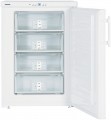Capacity
The total working volume of the freezer compartment. A larger volume allows for more products to be stored, but it affects the size and cost of the unit; therefore, when choosing based on this parameter, it's important not to chase maximum capacity but to consider what volume you actually need. For example, for household use, the average necessary volume is 50 liters per person; and when choosing a display freezer (see "Type"), you need to consider the number of products to be sold. More detailed recommendations for selecting the optimal volume can be found in specialized sources.
It is also worth considering that the freezer is often divided into several compartments (see below) — which means that a large volume does not necessarily guarantee that large pieces of products can fit into the device.
Number of compartments
it is the number of compartments provided in the design of the freezer. In some models, it is possible to set different temperatures for different compartments. It is worth noting that a large number of boxes does not always mean maximum convenience, since, with an increase in their number, the volume of each individual box inevitably decreases.
Max. temperature
The highest temperature maintained by the freezer during normal operation. This parameter is not as important as the minimum freezing temperature, however, it allows to evaluate the optimal conditions for storing certain categories of products that do not need deep freezing. And in some cases, it shows that the freezer can
work as a refrigerator.
Minimum temperature
The lowest temperature that the freezer can maintain in normal operation. First of all, the duration of food storage in the freezer depends on this parameter: it is believed that a temperature of -12 ° C is enough to preserve food for a month, -18 ° C – 3 months, -24 ° C – up to a year. At the same time, it must be taken into account that not only temperature affects the shelf life but also the type of product and its quality before freezing.
Power failure autonomy
The amount of time the freezer keeps food cold enough when the refrigeration system is turned off, for example, due to a breakdown or power outage. Technically, the power failure autonomy for each model is calculated differently; For example, for a freezer with an operating temperature of -18 ° C, this is the period during which the products in the chamber heat up from -18 ° C to -9 ° C. To sum up, the time is indicated during which the frozen products are guaranteed not to heat up to a temperature at which they could lose their properties.
Freeze capacity
One of the main indicators of freezer performance is the approximate amount of fresh food that the freezer can completely freeze from room temperature to the minimum operating temperature in 24 hours. For domestic use, a power of 10-15 kg/day is considered quite sufficient. More performant models may be required if you have to freeze a lot of food at a time or for industrial purposes.
Display
The external display makes the operation of the freezer more intuitive and allows you to control the conditions inside without opening it. The display can show data on the temperature inside the chamber or individual drawers, running programmes and the state of their running(fast freeze, for example), etc.
Child lock
The child lock allows you to block freezer controls and/or access to its internal volumes. This function will be useful in families where there are small children. Thus, the child will not be able to get to the freezer controls and change its operation mode.
Cold accumulators
The presence of removable refrigerants (cold accumulators) in the freezer design. This solution allows you to extend the temperature retention time in case of a power outage and also allows you to take it with you for use outside the freezer if necessary.

